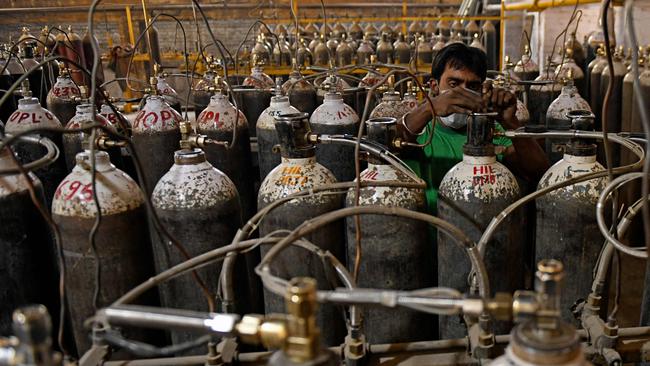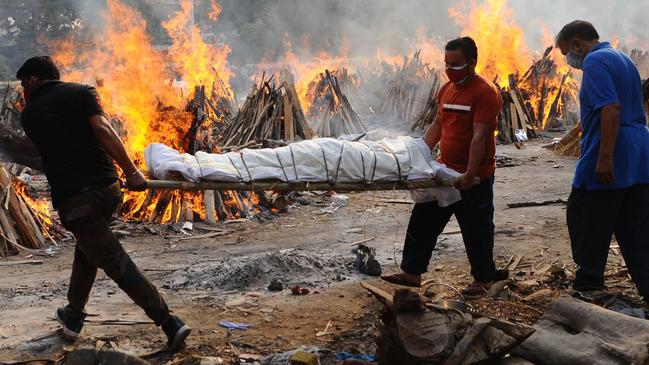India struggles under an epic humanitarian crisis
India is wilting under its second humanitarian crisis, fostered by the second wave of the coronavirus that is rampaging across the country more treacherously than the first a year ago.

India is wilting under its second humanitarian crisis, fostered by the second wave of the coronavirus that is rampaging across the country more treacherously than the first a year ago.
A farrago of failures of the government last year had confounded India’s desperate struggle against COVID-19, precipitating a humanitarian crisis of numbing proportions, but this time the government appears to have abdicated its mandate altogether even as an overstretched healthcare infrastructure disintegrates. As swirling infections slay the old as well as the young this time, multitudes are succumbing during endless waits outside hospitals that have run out of beds, intensive care units, medical oxygen, ventilators, lifesaving drugs — and vaccines.
Though Prime Minister Narendra Modi pledged to build a “New India” while seeking votes in the 2019 election, the country today is witnessing scenes that hark back to the pestilence of the Middle Ages.
Multiple bodies are heaped on to each pyre at some places, while elsewhere bodies are burnt in the streets as cremation and burial grounds run short of space. Infected patients are often crammed two to a bed in overstressed hospitals or on the floor in passages, next to bodies headed for the morgue. Often, COVID-ridden bodies are completely shrouded and hauled off for funerary rites out of sight of relatives.
An acute scarcity of oxygen is spurring mortality, with patients suffocating to death in front of their families who scramble helplessly to secure a cylinder, a bed or ventilator support. Barrages of corpses are overwhelming mortuaries, but the trauma continues for families who cannot find ambulances or hearses to take the bodies away. When they eventually do, they have another extended wait outside overstretched crematoria and cemeteries, and often there is not enough wood for funeral pyres. A black market that has emerged for wood, oxygen and lifesaving drugs has become a death sentence for those who cannot afford the price. Gravediggers are at times being asked to dig to twice the depth to accommodate two bodies at different levels.
The government’s abrupt imposition of the world’s largest and harshest lockdown last year that quarantined the population of 1.35 billion from March 25 had irrevocably shattered the lives and livelihoods of the country’s 500 million informal workers. Many today are starving or are entrapped into bonded labour.
This time the government has abandoned the entire population, with Modi coming on television on April 20 to ask state governments to determine their response to the COVID storm.

With mainstream media under unprecedented surveillance, news on the pandemic is at best doctored or underplayed, leaving social media as the most credible source of information. Even then, the focus is almost entirely on urban India, with the plight of the hinterland almost forgotten.
In the best of times, India’s health services are rickety. Eighty per cent of doctors and 75 per cent of dispensaries serve urban India, which is home to only a third of the population, leaving the rest in dire need of basic healthcare. There are only six beds per 10,000 population and one doctor for every 1457 people. These dismal ratios plummet in the villages.
While the government budgets 2.1 per cent of gross domestic product towards defence, the share of public health is a mere 1.1 per cent. India’s Economic Survey 2020-21 observes that India ranks 179th among 189 countries in prioritising healthcare in the government budget.
India recorded 386,452 new coronavirus infections on Thursday, the highest single-day rise so far, pushing the total tally to 18.8 million cases, with active cases crossing the 3.1-million mark, according to the Health Ministry data updated at 8am on Friday. The death toll increased to 208,330 with 3,498 new fatalities.
However, India’s figures are suspected of being enormously undercounted. Even conservative estimates place them at three times as much.
With all authority perceived to be arrogated by the Prime Minister, public disenchantment is growing as #ResignModi becomes a trending tag on Twitter. Netizens are holding the Prime Minister accountable for what they describe as the “Modisastrous” handling of the #SecondWave of COVID-19.
The government is hitting back. It denies any wrongdoing, blames the opposition and opposition-ruled states for all shortcomings, and has asked Twitter, Facebook, Instagram and YouTube to take down posts and URLs it accuses of spreading “fake or misleading information” to “create panic about the COVID-19 situation” and has even threatened to seize the properties of those who criticise its handling of the coronavirus.
With signs of a second wave clearly discernible the world over early this year, Modi took the moral high ground, claiming in January: “Last year, in February-March, many experts had said India will be the worst-affected country, there will be a tsunami of cases … Today, India is among countries that have succeeded in saving the maximum lives. The country, which comprises 18 per cent of the world’s population, has saved the world from disaster by bringing the situation under control.”
Last Sunday, Health Minister Harsh Vardhan acknowledged that “the dreaded disease is spreading like a tsunami”.
However, in January the leadership was preparing, then campaigning, for multi-phased elections in different parts of India scheduled from March 27 to Thursday this week. The public had called for postponement of the polls for fear they would be superspreaders of the virus, but the government went ahead. National leaders held mass rallies where almost all, including themselves, were without masks and social distancing.
Similar futile appeals were made to call off the religious festival of Kumbh Mela — the largest congregation in the world, with usual turnouts of 35 million to 50 million — held this month on the banks of the holy Ganges in north India. Government advertisements and hoardings bore outsized images of Modi with his salutation: “Holy Kumbh Mela offers devotees from the country and abroad a special occasion to witness the spiritual, cultural and social diversity of India.”
All this transpired despite the severe double mutant strain of the virus, branded B.1.617, making its appearance last October. This should have sounded the alarm bells and galvanised the government to action, especially when the Health Ministry was warned this new mutation could well turn into a triple mutant.
India’s vaccination program also got derailed when the government chose to redouble its “vaccine diplomacy” by exporting 64.5 million doses of vaccine to 84 countries in the early days since vaccination started on January 16, while only 52.1 million doses had been administered in India.
The administrative anarchy has inflamed social media, with netizens for the first time defying all threats in voicing their outrage.
Sarosh Bana is executive editor at Business India in Mumbai.



To join the conversation, please log in. Don't have an account? Register
Join the conversation, you are commenting as Logout